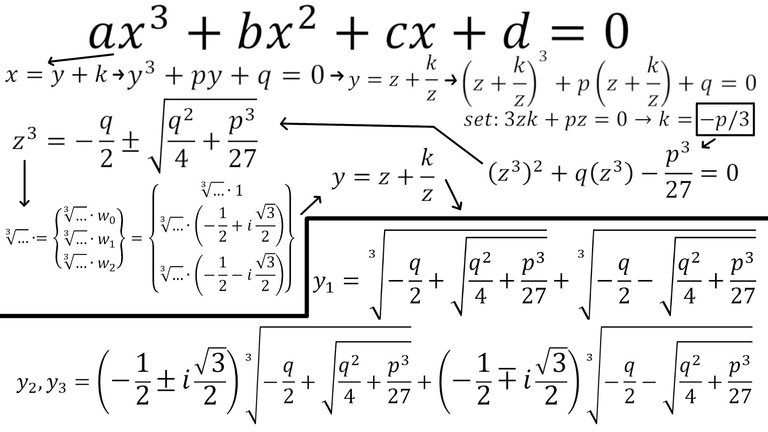In this video I go over the fourth step of the Cubic Formula proof which involves obtaining the complex solutions of y by considering the cube root of unity. Since the cube root of the z values from Vieta's substitution has 3 factors, we need to multiply the principle solution by the factors to obtain each separate solution. We solved the first solution already in the previous video, and that solution is termed the principle solution since it corresponds to the factor 1. The next two factors are complex numbers, but when we multiply them by z, we can apply the inverse relationship to simplify the equations. The result is just the principle solution of y with each term multiplied by one complex factor; the order is flipped for the other solution.
In the next video, I will plug these y-values back into the PQ substitution to obtain our x solutions.

Timestamps
- Step 4: Find the other solutions of y using the cube root of unity: 0:00
- First solution is just our previous or principle solution of y: 2:00
- Next two solutions involve multiplying by the complex roots: 2:36
- Solving the second solution of y: 3:26
- Solving the third solution of y: 6:28
Notes and playlists
- Playlist: https://www.youtube.com/playlist?list=PLai3U8-WIK0EF05ExjzLbB64NgUjoV1hl
- Notes: https://peakd.com/hive-128780/@mes/dzekfnxh .
Become a MES Super Fan! https://www.youtube.com/channel/UCUUBq1GPBvvGNz7dpgO14Ow/join
DONATE! ʕ •ᴥ•ʔ https://mes.fm/donate
SUBSCRIBE via EMAIL: https://mes.fm/subscribe
MES Links: https://mes.fm/links
MES Truth: https://mes.fm/truth
Official Website: https://MES.fm
Hive: https://peakd.com/@mes
Email me: contact@mes.fm
Free Calculators: https://mes.fm/calculators
BMI Calculator: https://bmicalculator.mes.fm
Grade Calculator: https://gradecalculator.mes.fm
Mortgage Calculator: https://mortgagecalculator.mes.fm
Percentage Calculator: https://percentagecalculator.mes.fm
Free Online Tools: https://mes.fm/tools
iPhone and Android Apps: https://mes.fm/mobile-apps
▶️ 3Speak